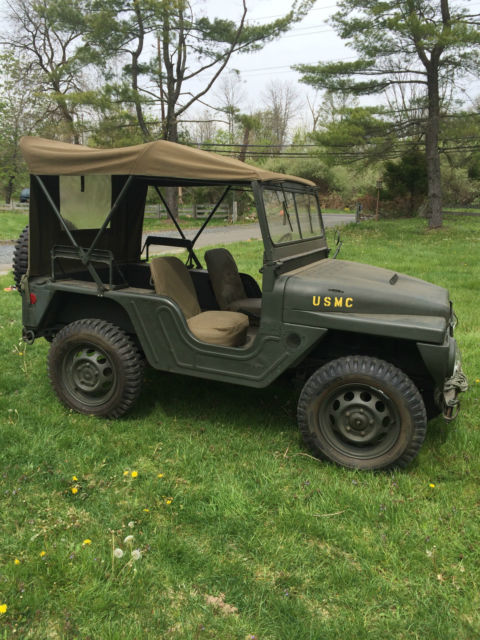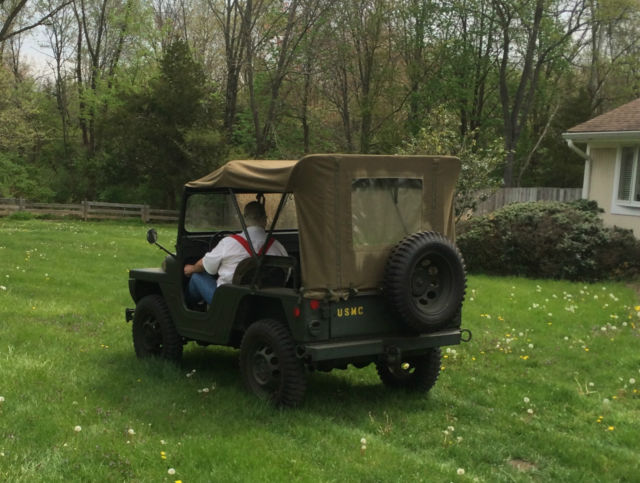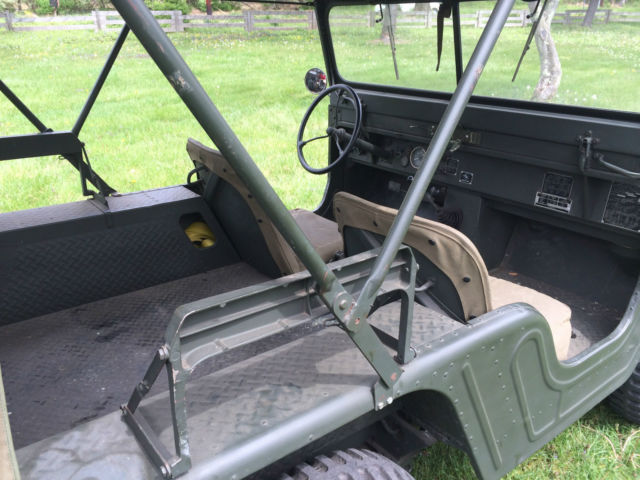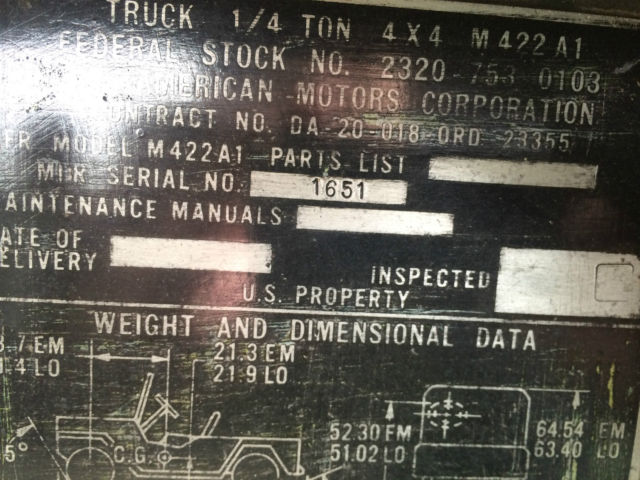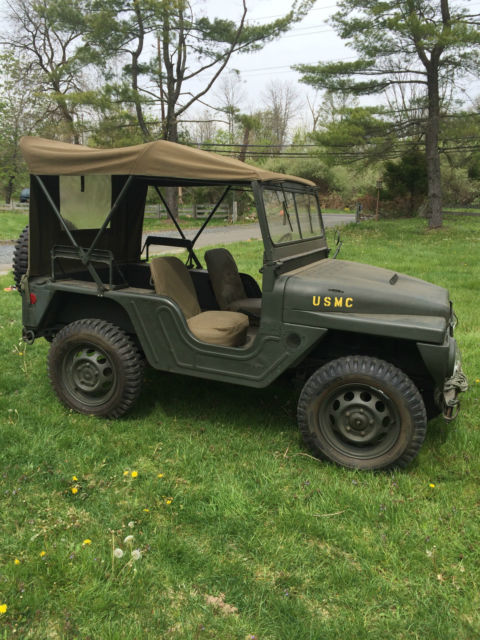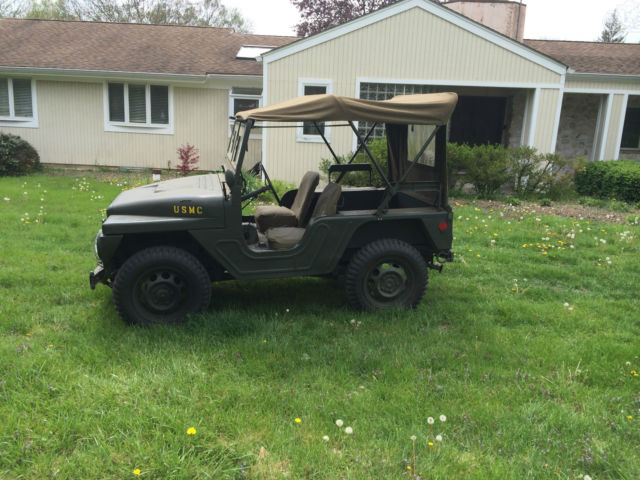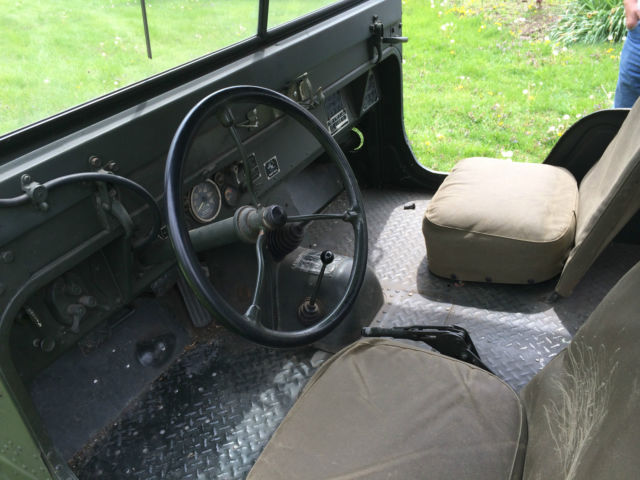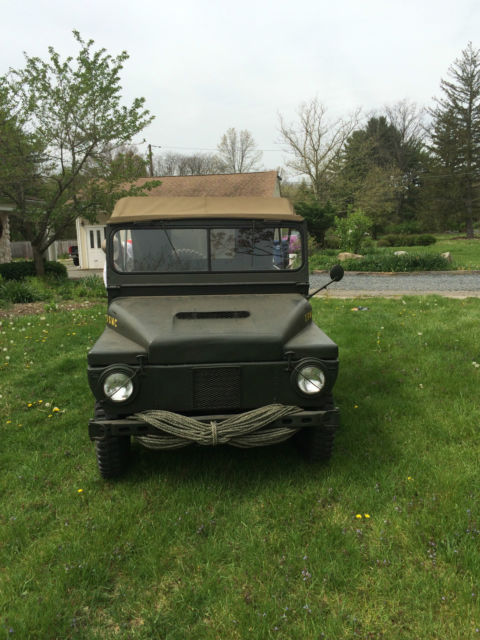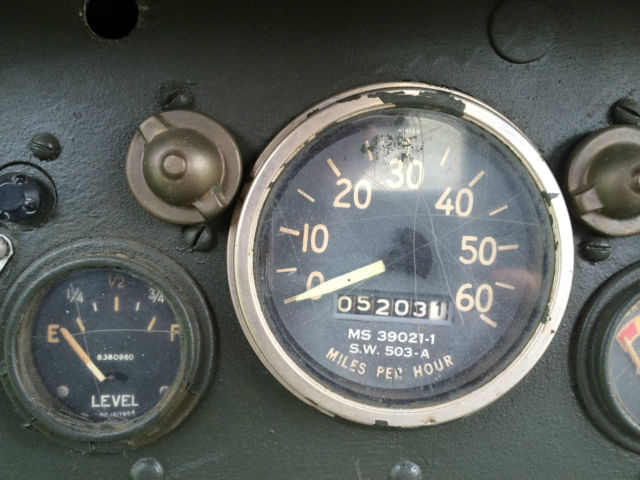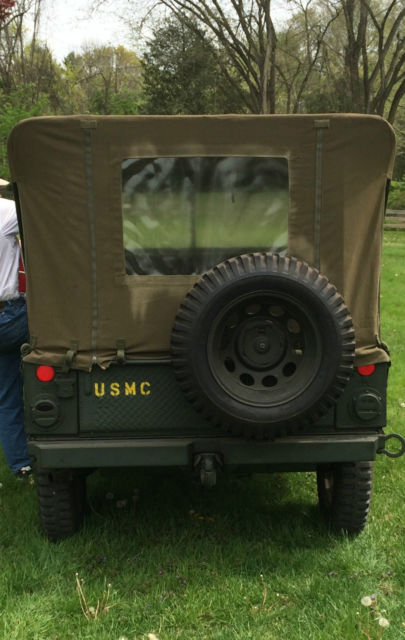M422A1 1961 American Motors "Mighty Mite" USMC "Jeep"
- Condition: Used
- Make: AMC
- Model: M422A1 '61 American Motors "Mighty Mite" USMC Jeep
- Type: M422A1
- Trim: USMC olive drab
- Year: 1961
- Mileage: 5,203
- Color: USMC olive drab
- Engine size: 4 cyclinder air cooled
- Number of cylinders: 4
- Fuel: Gasoline
- Transmission: 4 speed manual
- Drive type: 4WD
- Interior color: USMC olive drab
- Options: 4-Wheel Drive, Convertible
- Vehicle Title: Clear
- Interested?
1961 AMC M422A1 '61 American Motors "Mighty Mite" USMC Jeep Description
For sale is a 1961 American Motors USMC "Mighty Mite".The specialized vehicle, registration number 1651, is in excellent condition with just 5,203 miles on the odometer.As depicted in the photos, the original top and correct tires are in great shape.This model is one of the few surviving specimens of the 3000 that were originally built.
The jeep immediately starts up, idles well, and has considerable power for its small size.The clutch is smooth while the brakes and all the lines are in good working condition.All of the engine fluids along with the brake fluid have been swapped out as needed.This is a rare, special, and functional jeep in need of a new collector and appreciative owner.
THE SALES TERMS ARE "AS IS" WITH ALL FAULTS.NO EXPRESS OR IMPLIED WARRANTY IS PROVIDED.
A Mighty Mite Overview from Wikipedia:
The M422 'Mighty Mite' is a lightweight ¼-ton 4x4 tactical truck, suitable for airlifting and manhandling. From 1959-1962, the Mighty Mite was built by American Motors for the United States Marine Corps.
History
The vehicle was originally prototyped starting in 1946, making it the first all-new Jeep to be designed for the U.S. military after World War II, and further developed during the 1950s by a team including four of the original Bantam engineers. A design called MARCO MM-100 by the Mid-American Research Corporation used a Porsche air-cooled engine and independent suspension. A unique feature was the absence of a conventional exhaust system. The prototype did not have a muffler or pipe rather the exhaust was routed through the frame. This proved to be an inferior design because the condensation and acidic fumes caused premature frame failure. A competing prototype by Willys, the 1953 Bobcat or "Aero Jeep", which would share as many parts as possible with the M38 and M38A1 to save costs was rejected in favor of the more advanced M422.
Although the vehicle was only to be used by the U.S. Marine Corps, and it was therefore clear from the beginning that production numbers would remain limited, the vehicle was extensively engineered and incorporated many innovations.
Engineering
To keep the weight down, the M422 became the first U.S. Jeep to be fitted with an aluminum body. At 1,700 pounds (771 kg), it is the lightest of the American military trucks to date. Also, this was the first U.S. small military vehicle designed with independent suspension all around (front: leading arms/trailing arms rear), sprung by ¼-elliptical leaf springs. Among the M422's many other unique features were front and rear Limited-slip differentials, inboard differential mounted drum brakes, center-point steering, and the aluminum "AMC AV-108-4" V4 engine developed by American Motors. The air-cooled 107.8 cu in (1.8 L) developed 52 bhp (39 kW) and 90 lb·ft (122 N·m) of torque, which propelled it to a top speed of 65 miles per hour (108 km/h), with a 55-mile-per-hour (89 km/h) military rating. Like the M151 MUTT, the transfer case only engages/disengages the front wheel drive and is part of the transmission. The full synchronization meant it could be shifted from 2-wheel drive to 4-wheel drive on the fly.
Although basically a two-seater, the little vehicle could theoretically move six people, thanks to two additional fold-up seats that were integrated into the functional tailgate, as well as two folding backrests on the rear fenders. Also, the M422 was rated to carry 850 lb (390 kg) off road, while all other standard GI 1/4 ton vehicles (even the M151) were rated at 800 lb (363 kg). And if needed, there was even a version of the M416 trailer specially adapted for towing by an M422: the M416B1.
Like other USMC contract vehicles, the M422s came from the factory with all deep-water fording equipment installed, except for the pipes. In its early development stage the Marines developed a lightweight flotation kit that could easily be stored on the M442 when not in need, in which four large tubes inflated by exhaust encompassed the bottom part of the frame that allowed the vehicle to swim deeper waters. The vehicles wheels provided forward motion and steering in the water.
In 1958, seven prototypes passed grueling tests, and the first 250 vehicles were built by American Motors (AMC). These units went into mass production in 1960 and AMC built 3,922 Mighty Mites through 1962 for the U.S. Marine Corps. Over the years, the vehicle was produced in two model versions: the M422 and M422A1. The M422 had a tiny 65-inch (1,700 mm) wheelbase. After production of 1,045 units, the Mighty Mite evolved into the M422A1, six inches (152 mm) longer in both wheelbase and length, and 80 pounds (36 kg) heavier. The first Mighty Mites to have the 71" wheelbase were an experimental model fashioned from an M422. They had an extended, frame and aluminum added behind the seat and crudely fashioned tool storage boxes. This model was the M422E1 of which only a few were made. Once put into production the 71" wheelbase model was designated the M422A1. Either model could be fitted with rear mounted spare tire and a sturdier windshield similar to the Willys M38A1 that along with top bows would facilitate the use of a canvas winter top. The addition of the rear mounted spare tire rendered the tailgate unusable.
At over US $5,000 per unit, it was relatively expensive, and by the time the 'Mite' went into full production, the military's helicopters had become so much more powerful that the vehicle quickly became obsolete. The Marine Corps' Sikorsky H-19 with its 2,650-pound (1,202 kg) cargo limit (including crew and fuel), for which the M422 had been developed, was being superseded by the Vietnam era UH-1 “Huey", that could carry more than 1½ times that load. These factors may account for the small production total, as well as the short production time period.
Dimensions and weights
M422M422A1
Wheelbase65 in (1,651 mm)71 in (1,803 mm)
Length107 in (2,718 mm)113 in (2,870 mm)
Width60 in (1,524 mm)
Weight1,700 lb (771 kg)1,780 lb (807 kg)
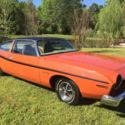 VERY RARE-AMC Matador "X" ~only 3277 ever made~ WILL SELL TO BEST OFFER
VERY RARE-AMC Matador "X" ~only 3277 ever made~ WILL SELL TO BEST OFFER
Mileage: 110,857
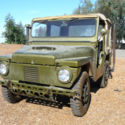 RARE,1962 AMC Mighty Mite,N422A1,Working Condition,Lots of new stuff come look
RARE,1962 AMC Mighty Mite,N422A1,Working Condition,Lots of new stuff come look
Mileage: 31,000
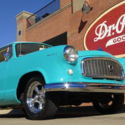 1959 American Motors Rambler American Deluxe Club Sedan AMC / mildly customized
1959 American Motors Rambler American Deluxe Club Sedan AMC / mildly customized
Mileage: 71,148
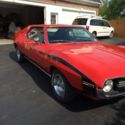 american motors 72 amc sst
american motors 72 amc sst
Mileage: 1,000,000,000
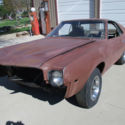 1969 American Motors AMX 390 4sp. Go pac
1969 American Motors AMX 390 4sp. Go pac
Mileage: 99,999
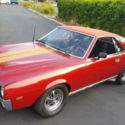 1969 American Motors AMX
1969 American Motors AMX
Mileage: 90,000
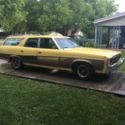 american motors ambassador
american motors ambassador
Mileage: 101,000
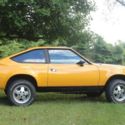 AMC Eagle SX4, 1982, American Motors
AMC Eagle SX4, 1982, American Motors
Mileage: 131,169
 1977 American motors Gremlin
1977 American motors Gremlin
Mileage: 71,755
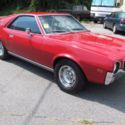 Rare Classic 1969 American Motors AMX
Rare Classic 1969 American Motors AMX
Mileage: 106,000
